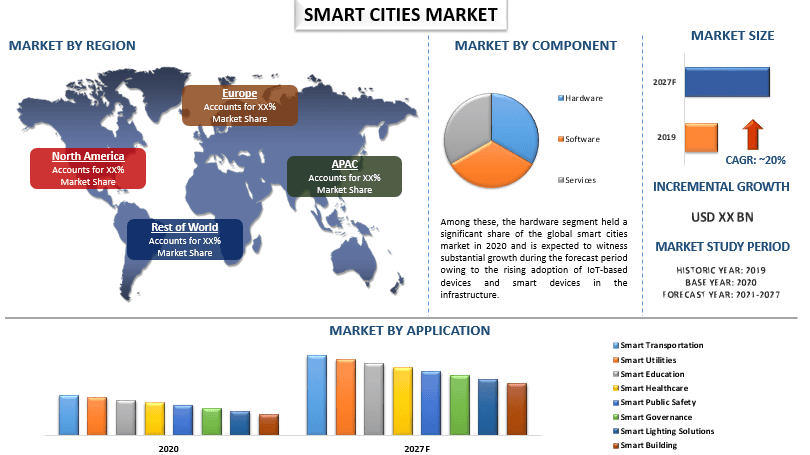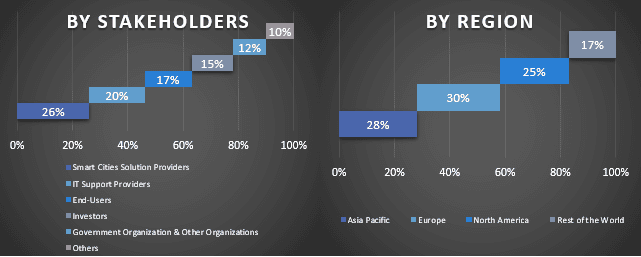- Home
- About Us
- Industry
- Services
- Reading
- Contact Us
Smart Cities Market: Current Analysis and Forecast (2021-2027)
Emphasis on Component (Hardware, Software, and Services); Application (Smart Transportation, Smart Utilities, Smart Education, Smart Healthcare, Smart Public Safety, Smart Governance, Smart Lighting Solutions, and Smart Building); and Region/Country

The global smart cities market is expected to register a CAGR of around 20% over the period of 2021-2027. The is rising on account of the growing urbanization, rising demand for strong IT connectivity & digitalization, the need for efficient management and utilization of resources, and increasing demand for a healthy environment with efficient energy consumption. Moreover, the growing demand for comfortable, fast, and efficient transport followed by public safety concerns will positively stimulate the industry landscape. A smart city is a municipality that uses information and communication technology to improve operational efficiency, share information with the general public, and improve both the quality of government services and the welfare of citizens. The main goal of smart cities is to use intelligent technology and data analysis to optimize city functions, promote economic growth, and at the same time improve the quality of life of citizens.
Cisco Systems Inc, International Business Machines Corporation, Microsoft Corporation, Schneider Electric, Siemens AG, ABB Inc, Vodafone Group Plc, Hitachi Ltd., Oracle Corporation, and Honeywell International Inc are some of the key players in the market. Several M&As along with partnerships have been undertaken by these players to facilitate customers with hi-tech and innovative products/technologies.
Insights Presented in the Report
“Amongst components, the hardware segment held a prominent share in the market in 2020”
On the basis of components, the market is segmented into hardware, software, and services. Among these, the hardware segment held a significant share of the global smart cities market in 2020 and is expected to witness substantial growth during the forecast period owing to the rising adoption of IoT-based devices and smart devices in the infrastructure. IoT is crucial for the successful completion of any smart city project because it helps in monitoring data, quick operation, the rapid adoption of new standards, better time management, automation, and control, saving money, etc.
“Amongst applications, smart education held a prominent share in the market in 2020”
Based on application, the market is categorized into smart transportation, smart utilities, smart education, smart healthcare, smart public safety, smart governance, smart lighting solutions, and smart building. Among these, the smart education segment held a prominent share of the global smart cities market and is expected to witness influential growth during the forecast period, mainly due to the expansion of smart devices in the education sector, increasing adoption of e-learning solutions, growing uses of artificial intelligence, machine learning, and big data analytics in education.
“North America to witness significant growth during the forecast period”
North America held a prominent share of the global smart cities market in 2020 and is expected to showcase a prominent growth rate during the forecast period. This can be attributed to the ongoing and previously completed smart city projects and the quick adoption of new technologies. In addition, the constant digital transformation in various industry verticals, such as government, telecom, and banking are further promoting the growth of the smart cities market in the region. Smart city projects completed in past years have helped North America to become a prominent region in the market. For instance, Chicago, Illinois launched the Array of Things initiative in 2016, which consisted of a network of sensors mounted on light poles collecting real-time data on the city’s environmental surroundings and urban activities. Data collected online from AoT is accessible online for providing valuable information and resources to researchers, urban planners, and the public.
Reasons to buy this report:
- The study includes market sizing and forecasting analysis validated by authenticated key industry experts.
- The report presents a quick review of overall industry performance at one glance.
- The report covers an in-depth analysis of prominent industry peers with a primary focus on key business financials, product portfolio, expansion strategies, and recent developments.
- Detailed examination of drivers, restraints, key trends, and opportunities prevailing in the industry.
- The study comprehensively covers the market across different segments.
- Deep dive regional level analysis of the industry.
Customization Options:
The global smart cities market can further be customized as per the requirement or any other market segment. Besides this, UMI understands that you may have your own business needs, hence feel free to connect with us to get a report that completely suits your requirements.
Table of Content
Research Methodology for the Smart Cities Market Analysis (2021-2027)
Analyzing the historical market, estimation of the current market, and forecasting the future market of the global smart cities market were the three major steps undertaken to create and analyze the adoption of smart cities in major regions globally. Exhaustive secondary research was conducted to collect the historical market numbers and estimate the current market size. Secondly, to validate these insights, numerous findings and assumptions were taken into consideration. Moreover, exhaustive primary interviews were also conducted, with industry experts across the value chain of the global smart cities market. Post assumption and validation of market numbers through primary interviews, we employed a top-down/bottom-up approach to forecasting the complete market size. Thereafter, market breakdown and data triangulation methods were adopted to estimate and analyze the market size of segments and sub-segments of the industry pertains to. Detailed methodology is explained below:
Analysis of Historical Market Size
Step 1: In-Depth Study of Secondary Sources:
Detail secondary study was conducted to obtain the historical market size of the smart cities market through company internal sources such as annual reports & financial statements, performance presentations, press releases, etc., and external sources including journals, news & articles, government publications, competitor publications, sector reports, third-party database, and other credible publications.
Step 2: Market Segmentation:
After obtaining the historical market size of the smart cities market, we conducted a detailed secondary analysis to gather historical market insights and share for different segments & sub-segments for major regions. Major segments included in the report as the component and application. Further country-level analyses were conducted to evaluate the overall adoption in that region.
Step 3: Factor Analysis:
After acquiring the historical market size of different segments and sub-segments, we conducted a detailed factor analysis to estimate the current market size of the smart cities market. Further, we conducted factor analysis using dependent and independent variables such as growing urbanization, the need for efficient management, and increasing demand for a healthy environment with efficient energy consumption. A thorough analysis was conducted for demand and supply-side scenarios considering top partnerships, mergers and acquisitions, business expansion, and product launches in the smart cities market sector across the globe.
Current Market Size Estimate & Forecast
Current Market Sizing: Based on actionable insights from the above 3 steps, we arrived at the current market size, key players in the global smart cities market, and market shares of the segments. All the required percentage shares split, and market breakdowns were determined using the above-mentioned secondary approach and were verified through primary interviews.
Estimation & Forecasting: For market estimation and forecast, weights were assigned to different factors including drivers & trends, restraints, and opportunities available for the stakeholders. After analyzing these factors, relevant forecasting techniques i.e., the top-down/bottom-up approach were applied to arrive at the market forecast for 2027 for different segments and sub-segments across the major markets globally. The research methodology adopted to estimate the market size encompasses:
- The industry’s market size, in terms of revenue (USD) and the adoption rate of the smart cities market across the major markets domestically
- All percentage shares, splits, and breakdowns of market segments and sub-segments
- Key players in the global smart cities market in terms of solutions offered. Also, the growth strategies adopted by these players to compete in the fast-growing market
Market Size and Share Validation
Primary Research: In-depth interviews were conducted with the Key Opinion Leaders (KOLs) including Top Level Executives (CXO/VPs, Sales Head, Marketing Head, Operational Head, Regional Head, Country Head, etc.) across major regions. Primary research findings were then summarized, and statistical analysis was performed to prove the stated hypothesis. Inputs from primary research were consolidated with secondary findings, hence turning information into actionable insights.
Split of Primary Participants in Different Regions

Market Engineering
The data triangulation technique was employed to complete the overall market estimation and to arrive at precise statistical numbers for each segment and sub-segment of the global smart cities market. Data was split into several segments & sub-segments post studying various parameters and trends in the areas of the component and application in the global smart cities market.
The main objective of the Global Smart Cities Market Study
The current & future market trends of the global smart cities market were pinpointed in the study. Investors can gain strategic insights to base their discretion for investments from the qualitative and quantitative analysis performed in the study. Current and future market trends determined the overall attractiveness of the market at a regional level, providing a platform for the industrial participant to exploit the untapped market to benefit as a first-mover advantage. Other quantitative goals of the studies include:
- Analyze the current and forecast market size of the smart cities market in terms of Value (USD). Also, analyze the current and forecast market size of different segments and sub-segments
- Segments in the study include areas of component and application.
- Define and analysis of the regulatory framework for the smart cities market industry.
- Analyze the value chain involved with the presence of various intermediaries, along with analyzing customer and competitor behaviors of the industry.
- Analyze the current and forecast market size of the smart cities market for the major region.
- Major countries of regions studied in the report include Asia Pacific, Europe, North America, and the Rest of the World.
- Company profiles of the smart cities market and the growth strategies adopted by the market players to sustain in the fast-growing market
- Deep dive regional level analysis of the industry
Related Reports
Customers who bought this item also bought










